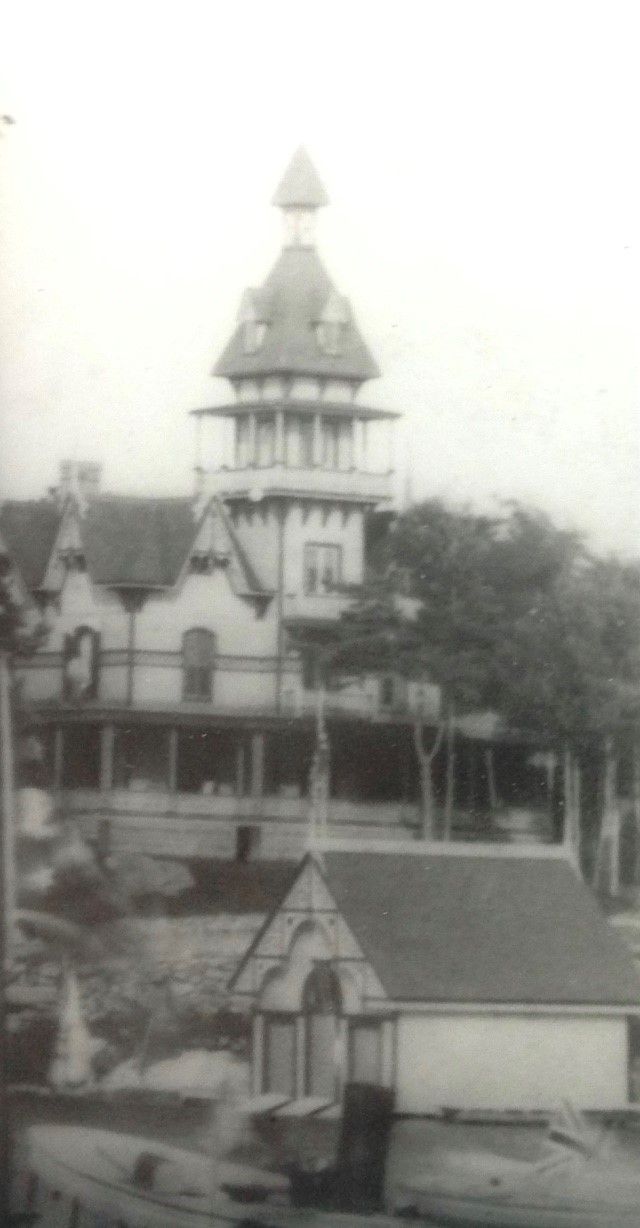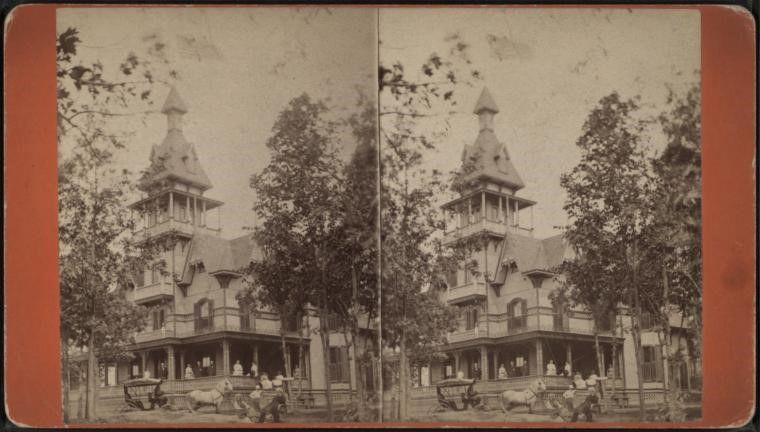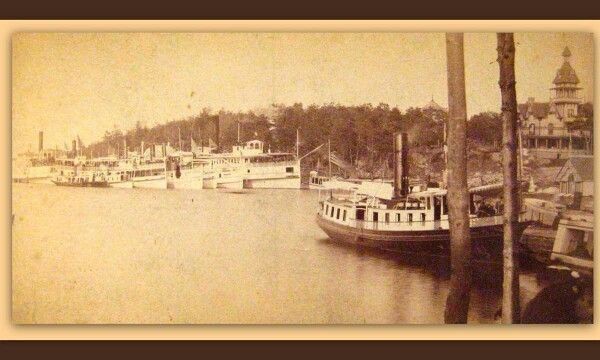The Westminster Park Board of Trustees carefully planned every aspect of their new island community: the placement of the Hotel, the Chapel, the roads and the lots, the docks, and all common areas. Possibly to establish a standard for private homes, they devised a contest of sorts, described in the “Watertown Re-Union”. The Trustees announced that they would “offer a prize lot of the value of one hundred dollars on their Park, for the best set of four designs for summer cottages, that will cost to build respectively, $250, $500, $750, and $1000, designs to consist of plans and elevation.” (Watertown Re-Union, December 27, 1877)

But the cottage of George R. Hanford of Watertown was in a category of its own. It was more a house than a cottage, holding a place of prominence over Poplar Bay. This house was a show-stopper. The Hanford family had their own special place in history as well.
George R. Hanford (1837-1922) grew up in Rodman, NY, but he moved to Watertown as a young man. Like many other Westminster forefathers, Hanford was a Civil War Veteran, a Republican and a Presbyterian, known to be an avid reader of the Bible. He had a long career in Watertown in the printing business, as a bookstore owner, and later, as a merchant selling pianos, organs, and sheet music. He served as the Secretary of the Watertown Chamber of Commerce, Treasurer of the Society for the Prevention of Cruelty to Animals, and for 20 years held positions in the insurance industry.
Hanford had a connection to Westminster Park, from its inception until his death in 1922. In 1879, Hanford promoted the area by selling three different editions of Boyd’s Handbook and Picturesque Guide Among the Saint Lawrence at his bookstore, Hanford and Waterman. This guide listed the lot owners of Westminster Park, as well as information on the beauty and development of the 1000 Islands. One could also purchase excursion tickets to travel to the 1000 Islands at Hanford’s shop.

George Hanford had a notable wife, Annie Wood Hanford (1839-1913).
Annie descended from a Watertown family. Her father, William Wood, was a well-known merchant and her mother, Ann, taught at the Watertown Young Ladies Seminary. The Woods built a house at 409 Washington Street where Annie grew up. She later inherited that house, and, upon her death, the house passed to George. The fame of the Wood family came from Annie’s mother, Ann Hooker Wood. Mrs. Wood was the sister of the famed Civil War hero, Major General Joseph Hooker. Maj. General Hooker, nicknamed “Fighting Joe”, was instrumental in leading many Civil War battles, including one at “Lookout Mountain.” He became a legend in the Hanford family. George Hanford inherited Hooker’s engraved watch and Hanford wore it every day until his death.
The story of the Hanford house in Westminster Park begins at the lot sale on May 23, 1878. Lot 101 was purchased by George Hanford’s wife, Annie Wood Hanford. Several years later, Annie also purchased other properties in Westminster.
In an 1881 article from the “Utica Morning Herald”, my favorite newspaperman, John J. Flanagan, reported “Secretary Hanford, of Watertown, will have an investment of from $7000 to $10,000 on the Park when his elegant new cottage is completed. Contractor A. R. Shannon of Watertown is busily at work blasting and making ready for the framing. The building will be 63x57 facing south/southwest across Poplar Bay, two stories in hight (sic) with a tower of 65 feet. The cottage will have all modern improvements and will be an attractive addition to the Park front.”

The Hanford’s named their Westminster house “Lookout Cottage.” The name reminds folks of the valor of Mrs. Hanford’s uncle in the Civil War and is fitting for the cottage on a high prominence looking out over Poplar Bay, the hotel, the docks, and much of the center of the community. I wonder if the 65-foot tower was accessible for observing the activities up and down the islands.

By the end of the summer of 1881, the construction of the cottage was complete, and the Hanford family took-up residence in their glorious home. Reports reveal that the “structure is the most costly one on the Park and is furnished with beautifully designed willow furniture.” Watertown Times, August 29, 1881.

I have read that the 19th century author Marietta Holley visited Westminster Park a number of times. Marietta Holley wrote a series of books under the name of Josiah Allen’s Wife. Her books were humorous accounts of a heroine, Samantha, and ordinary people’s lives with the intent of satirizing political and social mores of the time. She was a strong advocate of prohibition and of women’s rights, and a correspondent with Susan B. Anthony, Frances Willard, and Clara Barton. Some called her the “female Mark Twain” as her books sold over ten million copies. One of her books was entitled Samantha at Coney Island and a Thousand Other Islands. It is written in dialect and needs a motivated reader in the twenty-first century, but her heroine Samantha tells of her travels and experiences, with her usual biases. I always wondered why Miss Holley would come to Westminster Park. Some accounts say she stayed at the hotel; other accounts mentioned a cottage. As the story unravels, we learn that in her early career, Miss Holley wrote weekly articles for the “Watertown Post”. This paper was published by the firm of Hanford & Wood. With that business connection, it is apparent that Miss Holley and George Hanford were acquainted and that may explain her visits to the Westminster Park.
In August of 1885, Annie Hanford’s mother, Ann Hooker Wood, died while visiting in the Hanford cottage. Her health had been compromised for many years, and her death was not unexpected.
The Hanford family continued ownership of the Westminster House until 1887, when George Hanford sold the cottage to C. G. Tousey of Poughkeepsie, NY. I do not have much information about the Tousey family, but in 1890 the Tousey’s were embroiled in a family scandal, where it was claimed that Mr. Tousey was of “unsound mind”. Sometime after that, the house was sold to C. J. G. Hall, a prominent attorney from New York City. That sale to Mr. Hall ultimately introduced a new group of NYC people to Westminster Park and forever changed the history of the community. But that is a story for another day….
One additional note: If you are hoping to see this glorious house, you will be disappointed. It was lost to a fire in 1984.
Next month’s article will tell of another of Westminster Park’s founders and early citizens, Dr. J. D. Huntington.
© Linda Twichell 2018
Linda Lewis Twichell, a fifty-six-year resident of Westminster Park, has collected historical information on the Westminster community since the 1970’s. Presently, her research focuses on the lives of the people who settled here in the last quarter of the 19th century, and the cottages they built. A book of Westminster Park, its people, and their stories is in the works. Be sure to check out Linda’s other historical research published in previous issues of TI Life.
Comments posted on the old TI Life:
Comments
Comment by: Robert Charron
Left at: 1:11 PM Tuesday, January 15, 2019
A wonderful history of a prominent Westminster Park landmark. Looking forward to the next article about this cottage.
Posted in: Volume 14, Issue 1, January 2019, History, Places, People
Please click here if you are unable to post your comment.
